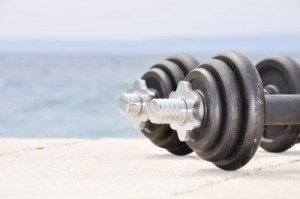 Weight training exercises can help develop casting muscles. These muscles can be developed through a program of resistance training. Gripping a long handled ax or sledge hammer like a rod and lifting it in sets of repetitions can develop these casting muscles. Perform 3 to 6 sets of 12 reps every other day for about 6 weeks. As strength develops use more resistance by increasing distance between ax head and wrist. Good casters have powerful power strokes and well-conditioned muscles. It requires wrist strength to keep the wrist motionless.
Weight training exercises can help develop casting muscles. These muscles can be developed through a program of resistance training. Gripping a long handled ax or sledge hammer like a rod and lifting it in sets of repetitions can develop these casting muscles. Perform 3 to 6 sets of 12 reps every other day for about 6 weeks. As strength develops use more resistance by increasing distance between ax head and wrist. Good casters have powerful power strokes and well-conditioned muscles. It requires wrist strength to keep the wrist motionless.
In addition, dumbbell training may help condition forearm casting muscles. Exercise the muscles used in the casting strokes motion by lying prone on a weight bench, and then while leaning over the bench lift the dumbbell in the back cast stroke. Forward cast muscles are developed by placing your back on the bench and reversing the exercise. Again, 3 to 6 sets of 12 reps are performed 3 times a week for at least 6 weeks. Increase resistance as strength develops.
Rotator cuff and shoulder exercises with high rep and low weight help keep you from getting sore on the river, as well as forearm and grip exercises for the same reason. Also, stretching helps to keep you more flexible. There are suggestions, however, from fishing experts, that recommend grips and casting techniques that can reduce casting injures, wrist pain, and shoulder soreness.
The most commonly taught and recommended grip is the V-style grip. In a survey conducted by fly fishing instructors those reporting use of the V-style grip indicated significantly less shoulder pain. It appears that the motions involved in casting probably favor the V-style grip as more natural for the shoulder. However, the wrist is flexed in all of the grips which is not a neutral position. Gripping the rod or line too tightly will cause muscle tension and pain, nerve compression in the hands, and loss of sensitivity. In addition, it puts too much energy into the cast, causing the rod to vibrate and to send waves down the fly line.
In fly casting, there are two motions for each cast. The back cast motion of the cast moves the line from the front to behind the caster. The forward cast motion moves the line from behind the caster forward. Overall, it appears that casting greater line lengths increases the demands on the shoulder, elbow, and wrist, but this may be ameliorated with greater skill and practice.
If your leisure activities include a lot of fishing, it is good idea to condition and strengthen accordingly. It is also clear that proper grips and casting techniques will improve the pain associated with the sport and make your leisure time more enjoyable.
Source: Physical Conditioning.” – Fly Fishing. Web. 03 Dec. 2012.Mitchell, Tamara. “Gone Fishing.” Working Well.com. Web. 3 Dec. 2012.
Follow Us: Facebook – Foursquare – Twitter – YouTube – LinkedIn
